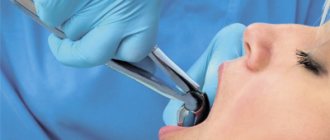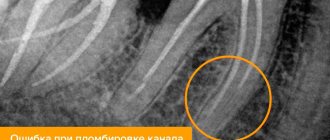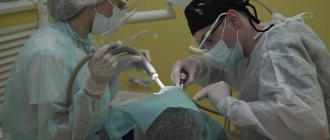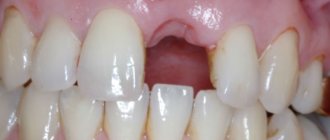Consultation with a doctor A pregnant woman is bombarded with myths from all sides about what can and cannot be done during this period. These superstitions even affect dental procedures. Pregnant women, listening to outside advice, refuse pain relief while undergoing gum treatment and endure pain, or try to avoid visiting the dentist altogether. But often such myths are completely inconsistent with modern reality. The article will help you figure out whether it is possible to treat teeth during pregnancy, remove them, take x-rays, give painkillers, or perform prosthetics.
Content:
- Is it possible to treat pulpitis in pregnant women?
- Features of the fight against pulpitis during pregnancy
- How to avoid pulpitis during pregnancy
- Risks to the fetus if pulpitis is not treated
Pulpitis is a disease in which the internal tissues of the tooth - the pulp - become inflamed.
It leads to severe pain symptoms. Toothache becomes especially severe at night. As the body tries to fight off the infection, your body temperature may rise. If pulpitis occurs in a pregnant woman, you should not hesitate to seek qualified dental care. The doctor can help the patient in an “interesting situation” without harming the health of the fetus. Under no circumstances should a woman tolerate the symptoms of the disease. Gradually they may disappear, but this does not mean that the inflammation has subsided. Simply, pulpitis will turn into a chronic form, which is very insidious.
IS ANESTHESIA POSSIBLE?
Removing a nerve is a type of surgery, so anesthesia is necessary. Naturally, during pregnancy, not just any painkiller is suitable, but only one that does not contain vasoconstrictors - adrenaline and norepinephrine. The most popular anesthetics among dentists, based on the substance "Artican", are not suitable for pregnant women, as they can cause a slowdown in the fetal heartbeat.
To control the removal process, it may be necessary to use x-rays; this, of course, is not very good for the fetus, so all precautions must be taken. Now there is a special device - a radiovisiograph, which displays an image on a computer monitor, while the radiation exposure is strictly controlled, narrowly directed and minimal.
Is it possible to treat pulpitis in pregnant women?
Thanks to the advent of safe medications and anesthetics, dentists today successfully treat pulpitis in expectant mothers. True, therapy in this case has some peculiarities.
Unfortunately, not all pregnant women know that pulpitis can be treated with it. Here are the main myths that cause women to put off visiting a dental clinic:
- Pregnant women should not have their teeth treated at all. This fiction has been circulating since the times of the Soviet Union. It is provoked by a misconception about the stages of the fight against pulpitis. This disease is most often a complication of advanced caries. This means that if you treat carious cavities in a timely manner and try to prevent their reappearance, then you will not have to suffer due to pulp damage. It is important to remember that pulpitis is an open gate for infectious agents. It can cause dangerous complications.
X-rays should not be taken during pregnancy. This is not fiction, but expectant mothers are offered to undergo diagnostics using modern diagnostic equipment that is not capable of harming the development of the fetus. In addition, x-rays are much less dangerous than the potential complications of advanced pulpitis, and the lesser of two evils should be chosen.- A lamp that provides light-curing fillings is harmful to health. This is also a myth. This dental device is nothing more than a source of blue light. It has nothing to do with ultraviolet radiation. The lamp has a filter that cuts out unwanted radiation, leaving only blue light. And it is not capable of harming your health.
- Arsenic, which is placed in a carious cavity, is toxic. This is true, but today doctors do not use this material. They place a safe composition into the cleaned recess in the crown, which affects only the dental nerve, but in no case the entire body of the patient.
Considering all this, we can say with confidence that it is possible and necessary to treat pulpitis in pregnant women. By refusing therapy and constantly taking painkillers, a woman harms her child much more.
Is it possible to do dental x-rays?
The most common misconception is that dental x-rays are prohibited during pregnancy. X-rays can indeed have a negative effect on the child, therefore such studies of the lungs and other organs are contraindicated during this period. But with dental x-rays, the risks are minimal, since:
- the emitted waves are so weak that they do not affect the baby;
- the rays are directed exclusively to the area under study;
- The chest and stomach are covered with a protective lead apron.
Under such conditions, the penetration of radiation through the tissues of the mother to the child is excluded.
Some clinics use dental microscopes for diagnostics instead of X-rays, the contraindications to their use are minimal.
Features of the fight against pulpitis during pregnancy
It is believed that the ideal period for treating the disease is the second trimester. In the first twelve obstetric weeks, if possible, any external interventions should be avoided, as all the internal organs of the child are formed. Starting from 13-14 weeks, you can safely engage in dental treatment.
That is why, at the planning stage for a child, you should visit a dentist and undergo an examination. This simple measure is guaranteed to avoid unpleasant surprises in the first months of pregnancy. But, if pulpitis occurs before the 13th week, you should not hesitate. You just need to warn the dentist about the “interesting situation.”
Taking into account the woman's pain sensitivity threshold, the dentist may suggest therapy without the use of anesthetics. But for severe pain, safe painkillers with minimal side effects must be used.
- First, the doctor cleans the cavity and puts medicine into it.
- A few days later the patient comes back for an appointment. The medicinal composition is extracted and the canals are cleaned.
- Safe temporary compounds are placed in the cleaned canals. Cover the hole with a temporary filling.
- The replacement of used materials with permanent ones is carried out after childbirth.
If you cannot do without an x-ray, it is better to replace it with radiovisiography. This technology is much more secure, but no less informative. With its help, you can check the condition of the canals and study the quality of the filling performed.
If a woman is allergic to any medications, analgesics, or dental materials, she must notify the doctor about this. Then the therapy will be tailored to the characteristics of her body.
Ways to relieve pain and inflammation
The safest and most effective way to reduce the pain and swelling that occurs after tooth extraction is to apply a cold compress to the cheek. If this measure does not bring the desired effect, then it is recommended to take analgesics: analgin, ibuprofen, ketanol, diclofenac, etc. The dosage regimen of the drugs is indicated in the instructions for them.
After complex extractions, patients are additionally prescribed antibiotics, since in these cases there is a high probability of developing purulent and inflammatory processes.
Important information! It is strictly forbidden to rinse your mouth for 7 days after removal of the chewing organ. This manipulation leads to the washing out of the blood clot from the socket.
How to avoid pulpitis during pregnancy
To reduce the likelihood of developing the disease during pregnancy, you need to:
Get examined at your dentist's office while preparing for pregnancy and in the first weeks after conception.- Visit the dentist promptly as prescribed by the gynecologist.
- Eat right, eat less sweets.
- Carefully monitor oral hygiene.
- Eat more fresh fruits and vegetables. They contribute to the natural cleansing of dental crowns from soft plaque.
- Use high-quality toothpaste and brush.
- Take prenatal vitamins prescribed by your gynecologist.
Incorrectly performed treatment
Poor quality materials and violation of treatment technology also cause pain. Reasons for such complications include:
- the channels are not completely cleaned;
- the nerve was partially removed;
- cavities remain under the filling material, leading to tissue destruction and the development of inflammatory processes;
- During filling, the material is moved beyond the apex of the root canal;
- The doctor did not notice any branches or lateral additional channels during treatment.
Risks to the fetus if pulpitis is not treated
An advanced disease can lead to infection entering the circulatory system. Then infectious agents will reach the placenta. And this can lead to fetal malformations.
It’s also bad that the expectant mother is nervous and worried because of the pain. Her emotional state can be described as negative. The result of constant stress is an increased release of cortisol, which also interferes with the full development of the baby.
Therefore, there is no need to refuse professional treatment for pulpitis. Having passed it, the pregnant woman will feel healthy and happy, which means that everything will be fine with her child.
How to alleviate the condition and prevent the problem
How many days can a tooth hurt after nerve removal? No longer than 7, otherwise this is no longer the norm, but a pathological condition requiring medical attention. After the manipulations, the dentist may prescribe a pain reliever, which must be taken immediately after the anesthesia wears off - this can be Tempalgin, Ketorol and others. On the first day after nerve removal and filling, you need to rinse your mouth with a soda-iodine solution; it will relieve irritation and inflammation of the mucous membrane and have a disinfecting effect.
Propolis is considered a good remedy - a small piece can be applied to the treated tooth and held for about an hour. Relief from soreness in the mouth will be brought by a cool compress of ice, wrapped in several layers of fabric and cellophane; it is not recommended to hold it for a long time, in order to avoid colds and pinching of the trigeminal nerve. It is not recommended to treat pain with warm compresses - perhaps this measure will help alleviate the condition, but it is considered pathologically dangerous.
Under the influence of heat, active proliferation of microbes begins, as a result, purulent contents accumulate in the tissues. It will enter the general bloodstream and cause blood poisoning (sepsis).
Now it is clear for what reasons a tooth may hurt after removal of a nerve, and which of them are considered normal and which require immediate treatment. It is not recommended to engage in therapy on your own at all, and in particular, you should run to the dentist if you begin to experience discomfort when swallowing saliva and water, there is an unpleasant odor coming from your mouth, and the gum tissue is very swollen. If symptoms are observed after the removal of a wisdom tooth or nerve, the matter may take a serious turn and require medical intervention.











